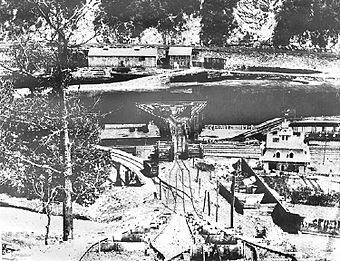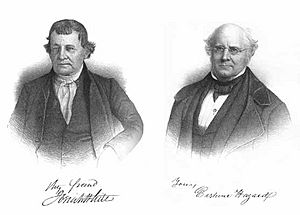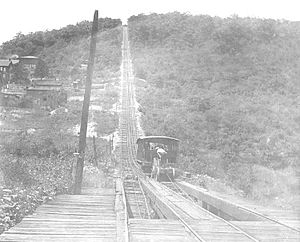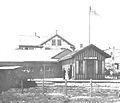Mauch Chunk Switchback Railway facts for kids
The Mauch Chunk and Summit Railroad was an important railway in the mountains of Pennsylvania. It operated from 1828 to 1932. This railway was the first in the United States to carry paying passengers for a long distance.
It was a private line built to move coal for the Lehigh Coal & Navigation Company. The tracks were laid on an older wagon road that went downhill for about 9 miles. The railroad worked for over 100 years until the Great Depression began.
Pennsylvania's first railroad and first anthracite carrier opened on Saturday, May 5th, 1827, when seven cars of coal passed from the Summit Hill mines of the L.C.&N. Company to their canal at Mauch Chunk, descending 936 feet in the nine-mile trip.
—Earl J. Heydinger
|
Mauch Chunk Railroad
Summit Hill & Mauch Chunk Railroad Mauch Chunk and Summit Hill Switchback Railroad |
|

Looking down at the Lehigh Canal landing, circa 1870.

Pisgah Mountain and the topography of the Summit Hill and Mauch Chunk Railroad
|
|
| Location | Between Ludlow St. in Summit Hill and F.A.P. 209 in Jim Thorpe, Carbon County, Pennsylvania |
|---|---|
| Area | 47 acres (19 ha) |
| Built | 1827, improved 1830s |
| Built by | Lehigh Coal & Navigation Co. (LC&N) |
| Architect | Josiah White |
| NRHP reference No. | 76001616 |
Quick facts for kids Significant dates |
|
| Added to NRHP | June 3, 1976 |
Contents
The Mauch Chunk Railroad Story
The Mauch Chunk Railroad was the second permanent railroad in the United States. It was also the first one longer than five miles.
Early Years: 1828-1845
In its early days, the Mauch Chunk Railroad used animal power. Mules pulled the empty coal cars back up the mountain. The mules would then ride down in the last group of cars. This whole trip took about 4 to 5 hours.
The railway used gravity to move coal cars downhill. It also had two special inclines to help cars go back up. These inclines led to the top of two different peaks on Pisgah Mountain. Each peak had a new track that went down several miles further west. This up-and-down design made the ride feel like a roller coaster. This design was later used to create actual roller coasters.
Around this time, new mines opened in the Panther Creek Valley. The Lehigh Coal & Navigation Company added more downhill switchback sections. They also added shorter cable inclines. These helped bring coal from the new Lansford and Coaldale mines. The coal then went to the Summit Hill area to be loaded onto the gravity railway. From there, it traveled down to Mauch Chunk and then to the Lehigh Canal.
The railroad became a popular tourist attraction. Many people consider it the world's first roller coaster. It continued to entertain tourists for over 50 years after it stopped being used mainly for coal.
Improvements: 1846-1871
By 1845, more and more coal was needed. The company realized they had to make their railroad better. In 1846, they built a new uphill line. This line used two steam-powered funicular systems. These systems were designed by Josiah White.
These new inclines used special Barney pusher cars. These cars were attached to cables and pushed the coal cars uphill. One incline went up 664 feet on Mount Pisgah. The other crossed Mount Jefferson. The downhill trip still used gravity.
The uphill track had a special safety feature. It had a ratchet that stopped a car from rolling back down if it came loose from the cable. This invention later led to the anti-rollback device used on roller coasters today.
The railroad changed its name to the Mauch Chunk, Summit Hill and Switchback Railroad. These improvements made a round-trip for passengers much faster. It went from 4.5 hours down to just 80 minutes!
Later Years and Closure
In 1872, the Panther Creek Railroad opened. This new railroad replaced the old switchback line for coal transport.
The Lehigh Coal and Railroad Company was one of the first American companies to use vertical integration. This means they controlled everything from getting the raw materials (coal) to shipping, processing, and selling the final products.
Many famous people visited this railroad. These included Prince Maximilian of Wied, President Ulysses S. Grant, William Astor, and Thomas Edison.
The Central Railroad of New Jersey (CNJ) bought the line in 1874. They leased it to brothers Theodore and H. L. Mumford. The brothers ran the line as a tourist attraction. On May 24, 1929, the CNJ sold the line to the new Mauch Chunk Switchback Railway Company. This company operated until 1932. The railway then closed because of the Great Depression. The property was sold for $18,000 to Isaac Weiner, who scrapped the line.
National Historic Site
In 1976, a 47-acre section of the old railway was listed on the National Register of Historic Places. This section goes from Ludlow Street in Summit Hill to F.A.P. 209 in Jim Thorpe. It was named the "Mauch Chunk and Summit Hill Switchback Railroad."
Today, the old railway path is used as the Switchback Railroad Trail.
Images for kids
- www.summit-hill.com - A local historian shares many scenes from the railway's 18-mile loop.














